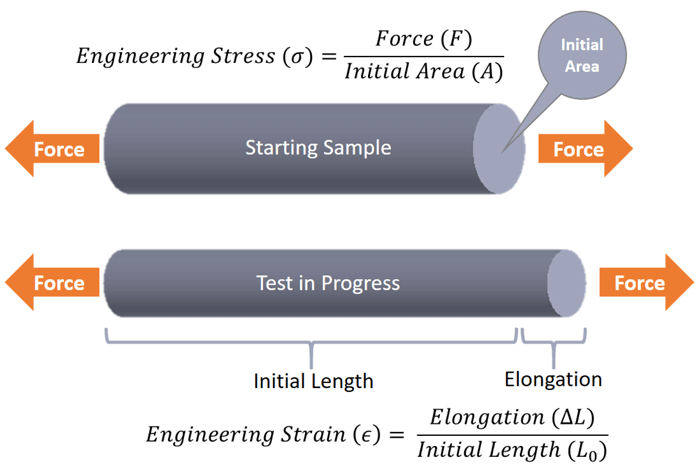Issue 005, January 28, 2021
Grant G. Justice, Research Metallurgist
Tensile testing is a commonly used materials characterization technique employed for repeatable measure- ment of mechanical properties of materials. Books have been written on tensile testing1,2, but this note will focus on a general explanation of what tensile testing is, and why it has become the preferred method of material characterization.
What is tensile testing? In modern tensile testing, a sample is clamped into a machine and slowly stretched until it fails. As the sample is stretched, data is logged for two variables: the force required to stretch the sample, commonly stated in newtons (N) or pounds (lb); and the length the sample has stretched or elongated, commonly in millimeters (mm) or inches (in). The force data are divided by the initial cross sectional area of the specimen to give the engineering stress on the sample. Stress is expressed in pounds per square inch (psi), or newtons per square millimeter (N/mm2) which is equivalent to a megapascal (MPa). Further, sample elongation data are divided by the initial length to give the engineering strain on the sample, generally expressed in percent (%). The use of sample dimensions in the calculations of stress and strain converts performance of a particular sample into general material properties that may be compared with tests using specimens of a dissimilar size.

Figure 1. Schematic diagram of tensile testing with relevant equations3.
What measurements are provided by tensile testing? A trained operator can extract a large amount of data on material performance from the stress- strain behavior of the material. The most common measured material properties are:
- Young’s Modulus: The rate of increase in stress with respect to strain in the material before permanent deformation occurs. In most metals, the elastic strain is small and difficult to accurately measure by tensile testing.
- Proportional Limit: The maximum engineering stress the material can be subjected to before any plastic (permanent) deformation occurs.
- Yield Strength: The engineering stress required to plastically (permanently) strain the material to a conventional offset threshold of 0.2%. This value is easier to measure and more commonly specified than the proportional limit.
- Ultimate Tensile Strength: The maximum engineering stress the material can be subjected to before it breaks.
- Total Elongation: The total engineering strain experienced by the material when it breaks.
- Plastic Elongation: The engineering strain remaining in the material after the material breaks and elastic strain is relieved.
- Strain Hardening: The rate at which engineering stress of the material increases as it is plastically (permanently) deformed.
Why is tensile testing used? Since the test loads the sample in tension uniformly over its cross section, it provides a repeatable measurement from which bulk material properties can be easily determined. Resulting properties are used to compare different materials or different grades of the same material. The test is also sensitive to defects in the material, in effect sampling the ‘worst case’ condition of the material. Any cracks, voids, or other defects will cause a reduction in tensile strength and elongation during testing, making tensile testing a meaningful quality assurance test.
What are the limits to tensile testing? The primary limitation to tensile testing is its ability to replicate real world material behavior. Most standard tensile testing is conducted slowly for ease of data collection, and room temperature for ease of operation. This produces reproducible data under laboratory conditions, but these rarely match actual use cases. Deformation speed, or strain rate, can significantly change the tensile behavior of a material, as can changes in temperature. Likewise, real world material loading is usually more complex including components of tension, compression, torsion, and bending. These limitations apply to most laboratory materials testing, not just tensile testing.
Overall, tensile testing is an excellent test method for measuring bulk material properties to serve as a basis for comparing the performance of different materials. It is an indispensable aid in alloy development, materials selection, and certification.
References:
1. Davis, Joseph R., ed. Tensile Testing. ASM International, 2004., https://www.asminternational.org/documents/10192/3465262/05105G_Chapter_1.pdf/e13396e8-a327-490a-a414-9bd1d2bc2bb8
2. Loveday, M.S., T. Gray, and J. Aegerter. “Tensile Testing of Metallic Materials – A Review – Final report of the TENSTAND project of work package 1.” (2004)., http://resource.npl.co.uk/docs/science_technology/materials/measurement_techniques/tenstand/test_method_review.pdf
3. ASTM E8 / E8M-16ae1, Standard Test Methods for Tension Testing of Metallic Materials, ASTM International, West Conshohocken, PA, 2016, www.astm.org
